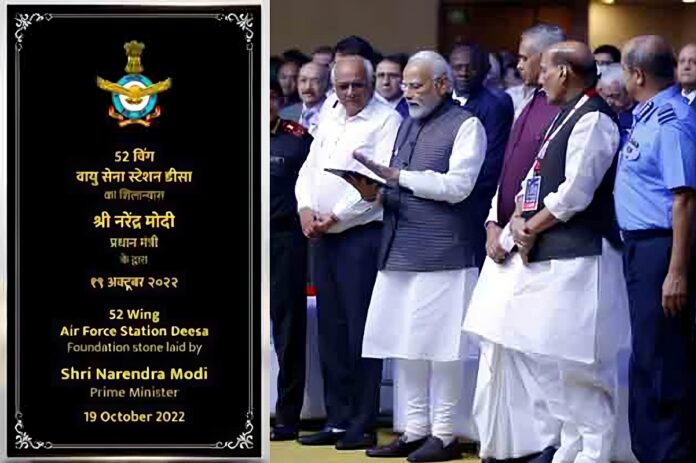Prime Minister Narendra Modi, on 19 October, laid the foundation stone for Indian Air Force (IAF)’s new airbase at Deesa in Banaskantha district of Gujarat and described it as an effective center of India’s security. He said the Deesa air base, mere 130 kilometers from the Indo-Pak border, will be able to give a better response to any threat coming from the west.
Importance
Deesa air base, the fifth in Gujarat, will be the firewall between Pakistani aircraft taking off from Mirpur Khas, Hyderabad, Shahbaz F-16 airbase in Jacobabad. Gujarat’s more than a trillion dollar industrial complex in and around Ahmedabad, Bhavnagar and Vadodara is a target for Pakistan in the worst-case scenario.
While Modi said the Deesa airbase will provide faster offensive capability to the IAF in this sector, the new airfield will also plug a crucial tactical gap between forward air bases at Naliya, Bhuj in Gujarat, and Phalodi in Rajasthan.
Deesa will also make Pakistani cities of Hyderabad, Karachi, and Sukkur vulnerable with its deep penetration strike aircraft.
The airbase can also be used to retaliate against Pakistan in case of a major terror strike in Gujarat or along the south-western sector apart from giving support to any land offensive in future. Indian fighters can cross over the international border in mere two minutes at Mach 2.0 speed if the red flag goes up.
Background
Although the land for Deesa airbase was allotted an in-principle approval given to IAF by the Vajpayee government way back in 2000, the project was put on a back burner by the UPA government for the next 14 years. The project was revived when Narendra Modi took over as prime minister. It was the 2017 massive floods in Banaskantha that really kick-started the project.
When prime minister Modi and then defence minister Nirmala Sitharaman asked IAF to provide flood relief, the Air HQ, then headed by Air Chief Marshal BS Dhanoa, found it very difficult to provide a relief air bridge to the affected areas due to bad weather and no nearby airfield as Deesa was still lying in files. Defence minister Nirmala Sitharaman got the airbase approved by the government along with the Rs 1,000 crore funding.
Operational Status
Since Deesa is a forward airbase, the IAF has no intentions to deploy its frontline Rafale or Su-30 MKI fighters on this airfield. Instead, it will station air defence fighters like MiG-29 and Tejas so that enemy fighters are intercepted and their ability to target Gujarat’s industrial complex gets neutered.
Spread over an area of 4,519 acres and 130 km from the Indo-Pak border, Deesa is a greenfield air base. It is expected to be operational by 2024. The airbase, which currently only has a 22-kilometer boundary wall and 20 watchtowers, will be developed in two phases.
Phase 1 of the project will see the construction of the main runway, the taxi tracks, and the fighter squadron dispersal area. Phase 2 will take care of the technical infrastructure and accommodation, according to a report by India Today.
The Deesa airbase will come under the South Western Air Command. It will also help in improving surveillance in and around the region. Gujarat has four operational air bases in Vadodara, Jamnagar, Bhuj and Naliya in the Kutch district.
One of the primary reasons for constructing the Deesa air base is to protect the Jamnagar oil refinery owned by Reliance Industries Limited, which is also the world’s largest oil refinery.
Deesa will also endanger the Pakistani cities of Hyderabad, Karachi, and Sukkur with the IAF’s deep penetration strike aircraft.
Overall, the Deesa air base will provide the IAF with a faster offensive capability.
The new airbase will also close a tactical gap between the IAF’s forward air bases at Naliya, Bhuj in Gujarat, and Phalodi in Rajasthan.


















